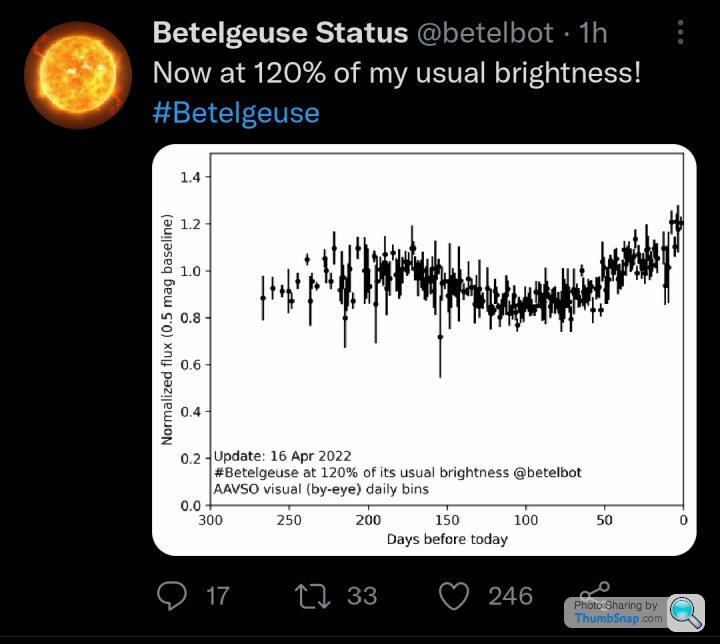Betelguese getting some attention for dimming
Discussion
We have never seen a star in clear detail BEFORE it went bang - so trying to predict what happens in the immediate months, weeks and days before a supernova occurs is problematic. Obviously, keeping an eye on Betelgeuse at the moment might provide us with exactly that kind of information.
However, the evidence now seems to be that the changes we have seen occurring on Betelguese over the past six months are more to do with gas and dust surrounding the star rather than internal changes in the star itself.
However, the evidence now seems to be that the changes we have seen occurring on Betelguese over the past six months are more to do with gas and dust surrounding the star rather than internal changes in the star itself.
Eric Mc said:
No, just boring old lightening up a bit. I think the dimming was caused by a dust cloud moving in front of the disc and it is now moving out of the way.
Apparently notarticle said:
This part of the electromagnetic spectrum is particularly good for observing the distribution of cosmic dust.
"What surprised us was that Betelgeuse turned 20% darker even in the submillimetre wave range," said co-author Steve Mairs from the East Asian Observatory in Taiwan, which operates the JCMT.
The result isn't compatible with the presence of dust, say the researchers. Instead, the astronomers say, temperature variations in the photosphere - the luminous surface of the star - most likely caused the brightness to drop.
"Corresponding high-resolution images of Betelgeuse from December 2019 show areas of varying brightness. Together with our result, this is a clear indication of huge star spots covering between 50% and 70% of the visible surface and having a lower temperature than the brighter photosphere," said co-author Peter Scicluna from the European Southern Observatory (Eso).
https://www.bbc.co.uk/news/science-environment-53218658"What surprised us was that Betelgeuse turned 20% darker even in the submillimetre wave range," said co-author Steve Mairs from the East Asian Observatory in Taiwan, which operates the JCMT.
The result isn't compatible with the presence of dust, say the researchers. Instead, the astronomers say, temperature variations in the photosphere - the luminous surface of the star - most likely caused the brightness to drop.
"Corresponding high-resolution images of Betelgeuse from December 2019 show areas of varying brightness. Together with our result, this is a clear indication of huge star spots covering between 50% and 70% of the visible surface and having a lower temperature than the brighter photosphere," said co-author Peter Scicluna from the European Southern Observatory (Eso).
ash73 said:
Aliens. The EU. Some other scapegoat favoured by absolute bell ends.The Wookie said:
Forgive my ignorance of this but Sunspots of that size must indicate there's some pretty substantial action going on inside the star?
Is it a prelude to a supernova, even if it's 1000 years away?
Very big stars have very big sunspots.Is it a prelude to a supernova, even if it's 1000 years away?
And these very big stars also have very tenuous outer layers. They are nothing like as well defined as a "normal" star.
Eric Mc said:
The Wookie said:
Forgive my ignorance of this but Sunspots of that size must indicate there's some pretty substantial action going on inside the star?
Is it a prelude to a supernova, even if it's 1000 years away?
Very big stars have very big sunspots.Is it a prelude to a supernova, even if it's 1000 years away?
And these very big stars also have very tenuous outer layers. They are nothing like as well defined as a "normal" star.
Learn something everyday.
Eric Mc said:
With red giants, the core is quite far from the outer surface. In effect, the outer layers have been puffed out leaving the core behind. As the outer layers expand, they cool - giving the red appearance.
Interesting, that helps it make sense for the large sunspots for me tooIt seems that VY Canis Majoris is doing something similar but far bigger:
https://phys.org/news/2021-03-hubble-mystery-monst...
https://phys.org/news/2021-03-hubble-mystery-monst...
dukeboy749r said:
It might still go super nova within all of our lifetimes, on the premise it might already have done so 600 odd years ago.
It’s fascinating that we are watching light from around the 1400s (in Earth time).
The vastness of space is too big to comprehend. The size of Betelguese its self is mad in comparison to your solar system. It’s fascinating that we are watching light from around the 1400s (in Earth time).
Scabutz said:
dukeboy749r said:
It might still go super nova within all of our lifetimes, on the premise it might already have done so 600 odd years ago.
It’s fascinating that we are watching light from around the 1400s (in Earth time).
The vastness of space is too big to comprehend. The size of Betelguese its self is mad in comparison to your solar system. It’s fascinating that we are watching light from around the 1400s (in Earth time).
annodomini2 said:
Scabutz said:
dukeboy749r said:
It might still go super nova within all of our lifetimes, on the premise it might already have done so 600 odd years ago.
It’s fascinating that we are watching light from around the 1400s (in Earth time).
The vastness of space is too big to comprehend. The size of Betelguese its self is mad in comparison to your solar system. It’s fascinating that we are watching light from around the 1400s (in Earth time).
 t, I've outed myself. Take me to your leader at once.
t, I've outed myself. Take me to your leader at once.Typo obvs
Gassing Station | Science! | Top of Page | What's New | My Stuff





